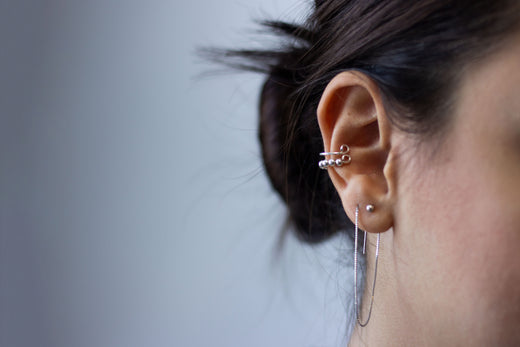Earwax blockage is a common issue that affects many people. While earwax plays a crucial role in protecting our ears, excessive or impacted earwax can lead to discomfort and other problems. This article explains the causes of earwax blockage and offers practical solutions for managing it.
Causes
Understanding why earwax buildup occurs is key to managing and preventing blockages effectively. Various factors contribute to this common issue:
-
Biological Factors: Just like certain physical traits, the amount of earwax produced varies from person to person. Some individuals naturally produce more earwax, predisposing them to potential blockages.
-
Ear Anatomy: The structure of one's ear canal influences the likelihood of earwax accumulation. People with narrower or hairier ear canals may experience more frequent blockages due to the physical constraints of their ear's architecture.
-
Age-Related Changes: Aging affects earwax production and consistency. Older adults often have drier and harder earwax, making it more prone to forming stubborn blockages.
-
Technology Interference: Regular use of devices like earphones and hearing aids can inadvertently push earwax deeper into the canal, leading to compaction.
-
Inappropriate Ear Cleaning Methods: Common practices, such as using cotton swabs for ear cleaning, often backfire. These methods push the wax deeper rather than removing it, exacerbating the problem.
Symptoms
Recognizing the signs of earwax blockage is crucial for timely and effective treatment:
-
Feeling of Fullness: A sensation of having something blocking the ear, similar to the feeling of stuffed cotton in the ear canal.
-
Ear Pain and Discomfort: Persistent discomfort or a dull ache in the ear can be a sign of blockage.
-
Reduced Hearing: Muffled or diminished hearing, akin to the sensation of being underwater, often indicates earwax buildup.
-
Tinnitus: Experiencing a ringing or buzzing sound in the ear, not caused by external noises, can be a symptom of earwax blockage.
-
Itchiness and Odor: Itchy ears or an unusual smell emanating from the ear canal can be a warning sign of excessive earwax.
Risks
Leaving earwax blockage unaddressed can lead to several complications. It's important to understand these risks to appreciate the importance of managing earwax buildup:
-
Hearing Loss: Continuous blockage can result in temporary or at rare occasions permanent hearing loss due obstructing the ear canal.
-
Ear Infections: Earwax accumulation creates an environment conducive to bacterial growth, potentially leading to painful ear infections.
-
Eardrum Damage: Extreme cases of earwax blockage can cause pressure buildup, especially if improperly treated, leading to eardrum damage or perforation.
-
Tinnitus Worsening: Existing tinnitus symptoms can intensify due to the additional pressure and obstruction in the ear caused by a blockage.
-
Quality of Life Impact: Chronic earwax blockage can adversely affect daily activities and overall well-being - leading to discomfort, social withdrawal, and communication difficulties.
Treatment
Dealing with earwax blockage involves safe and effective treatment methods. Two commonly recommended treatments are professional ear cleaning and the use of ear irrigation devices. For a comprehensive comparison of the most common ear cleaning methods, check out our article here.
Professional Ear Cleaning
Professional ear cleaning is a safe and effective method for removing earwax, conducted by healthcare professionals using specialized tools. It ensures a tailored approach to earwax removal, catering to individual ear conditions and varying levels of wax buildup. Alongside earwax removal, this method often includes a comprehensive ear examination, offering an opportunity to identify and address underlying ear health issues.
While professional cleaning is the safest option for earwax removal, it is significantly more expensive compared to other methods. This process is not required for most people on a regular basis, but it is an excellent choice for those in need of a thorough and safe earwax removal process.
Ear Irrigation Devices
Ear irrigation, utilizing a gentle stream of water or saline solution, effectively removes large accumulations of earwax. This method thoroughly cleans the entire ear canal, surpassing the efficacy of superficial cleaning methods. Ear irrigation kits typically regulate water pressure to ensure safety, minimizing the risk of ear damage.
However, improper use can introduce bacteria, potentially leading to bacterial infections. The method can also be complex compared to other at-home treatments. It is not the most suitable method for everybody, especially those with specific ear conditions and a prescribed set of treatment from a qualified medical professional. Using high-quality devices like the Auracle Eddy can mitigate these risks, making ear irrigation a viable option for regular earwax maintenance when performed correctly and with the appropriate equipment.
Conclusion
Earwax blockage, a common yet often overlooked issue, arises from various factors such as individual biology, ear anatomy, and lifestyle choices. Recognizing its symptoms is crucial for timely management to prevent complications like hearing loss and infections. Treatments include professional ear cleaning for a safe, thorough approach, and ear irrigation for a more accessible, regular maintenance option. Both methods require careful consideration of individual needs and circumstances. Proper understanding and management of earwax buildup are essential for maintaining ear health and overall well-being.








Share:
Related Blogs
Best Methods to Remove Earwax
Candle Ear Treatment: Do Ear Candles Work?